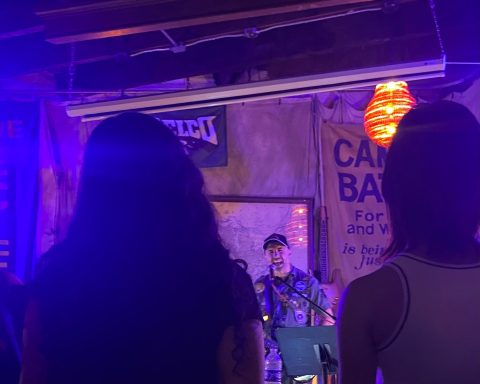Editor’s note: This article was initially published in The Daily Gazette, Swarthmore’s online, daily newspaper founded in Fall 1996. As of Fall 2018, the DG has merged with The Phoenix. See the about page to read more about the DG.
The Crum Creek Meander existed on the Swarthmore campus for nine months. While the artwork had been the center of student criticism during its run, it still holds a place in the college’s memory and history. Yet, little was heard from the artist herself, Stacy Levy.
Levy describes herself as an artist who is like a “player on a stage,” creating temporary experiences that people partake in, rather than objects that are to be sold. Her works collaborate with nature and are always changeable and responsive. Like the Crum Creek Meander, her other works also encourage audience interaction.
The Daily Gazette (DG): Now that the Crum Creek Meander is gone, what will the materials be used for?
Stacy Levy (SL): The [Swarthmore] Co-op is taking some. They are taking an opening’s worth. And Swarthmore College needs a garage opening’s worth. Habitat For Humanity is taking the rest. The vinyl’s original use is to separate two spaces. Either cold or hot, or dirty and clean. The Co-op will use it where their packages come in. You always see this in the baggage claim, and they always put black [vinyl strips]. That is what inspired me to do the black ones. I travel a lot and I spend a lot of time waiting for my baggage to come through and I was staring. It is very, very beautiful, very reflective.
DG: Yeah. A lot of students were very curious why the black was in there.
SL: It was the reflectivity. At the very bottom, it also made this whirlpool that was a private architectural space.

DG: Like sealing off the environment?
SL: Yeah! And it was seven degrees warmer in the winter. It was amazing how the snow melted inside there. It was like a different microclimate altogether. You have this huge campus, but most of it is big open spaces. It is nice to have a little room in the midst of one of your great lawns. And the black also have this feeling of what was lower down on the stream, when the stream was getting dirtier and dirtier with the nonpoint source pollution of the wash that is coming off the roadways that is filled with petroleum, and the lead and the things that are inside of tires.
DG: Yes, I think it was really beautiful. But there are some who disagree. Have your heard the criticism by the students on campus?
SL: I know some of the students have problems with it being plastic. That is the criticism I have heard, there are probably others. I find this interesting because everyone’s life is plastic. You are walking around in fleece, you are walking around in plastic. You are walking around in plastic sneakers and you drink water from plastic bottles and you throw your trash into plastic trash cans. I like to take these materials of everyday and turn them around and make them mean something completely different. So it is interesting these very sophisticated students couldn’t get over how it is plastic.
But it is my job as an artist to introduce you to something you’ve never seen before, so when you go get your luggage from the baggage claim and you see that material, you will see it differently. When you see it fly at the back of a truck that is loading in and out frozen fish, you will think about that material: that material will have a different resonance to you. That’s my job. My job is also to use it and then find another home for it. So it has to be a very practical material. When you are building for a year, it is like building for ten years because you have all sorts of weather that comes through here. The material has to be super strong, and there is not much in the world that is as strong and flexible and transparent as plastic. The fact that it could blow for so many months and not be shredded or brittle and broken is kind of really amazing.

DG: I am sure when you came back, you sometimes saw the poles being bent. How did you feel about that?
SL: Well, the poles got bent because it was used in a way that was really great. People swung on it, and they used it as a swing. And they climbed on it, and that’s great. If it was a permanent piece, I would have built it to carry that kind of weight. But because it is a temporary piece, we just didn’t have the budget to build it in the robust way that play equipment needs to be built in. But I think it would have been great. We saw kids who were tying the strands low and they would get some height and they would tie the next strand a little higher, so they create a staircase in the curtain so that they can reach the top bar. I thought that was brilliant. I mean, that is a great engineering mind there.
DG: What are your works largely based on? Wind?
SL: No, but they are all based on some natural processes, so a lot of them are wind. I love working with rainwater because it gives you a way to process something that needs to be processed that nobody wants to deal with and is typically put down in a pipe. I want to celebrate rainwater and make it highly visible and useful, too, so it doesn’t just get thrown into the nearest creek – which is very bad for the creeks – but to have it soak into the ground. So I do a lot of works which slow the rain down and give it a home, a place to soak in, and the time to soak in. And those pieces are usually permanent.
DG: When I talk to you, I feel like I am talking to a scientist.
SL: Art and science are very, very close. Both artists and scientists have tremendous curiosity about the world. We are excited about it, and we want to see how it works and then tell other people about how it works. Jackie Brookner had this beautiful quote: “Artists and scientists are twins born of awe.” There is a slight divergence about how they deal with what they discover, but basically we are a very kindred spirit. I work with scientists all the time, and they love it and I love it. There is just a slightly different mechanism of how far they can stretch the boundaries, because they have a little bit more factual issues. I just found out they have the same grant writing issues that I have.
DG: Do you know what other people thought of the Meander?
SL: Dog walkers really loved it, and people who had kids really loved it because their kids would go play in it all summer. But the students all came out to take pictures on the last day. It was like everyone came out of the woodwork. A lot of students came up and said how much they liked to be in it. They knew they weren’t supposed to like it, but they liked it all the same. So I thought that was good.
DG: Why do you think the students weren’t supposed to like it?

SL: I don’t know. I think students are at a point in their lives where they are actually adverse to change, because they have not been around long enough to know that change passes through, and I think people have a funny relationship with things that spring up in what they consider their backyard. They don’t like things that sort of fold into a situation. I’ve heard a lot of situations where students get very worked up about the addition of an artwork on their campus, but aren’t really reflective about their recycling system. I think it is a funny conundrum, I think it is very much to do with this sort of age. I guess as an adult you see a lot of destruction and change and [you are open to] something that isn’t destructive.
DG: Did you work with any students?
SL: Yeah, we worked with a couple during the water collection [during the concurrent exhibition at the List Gallery]. Students are really busy here, so they didn’t have time to go running around. Which is sort of sad that you get so busy when you are young that you don’t have time to do the odd things that you will probably remember in life more. I was a really serious student when I was in school, and I spent too much time in the library. I should have been out exploring more. I wish I had just taken on these odd adventures that I just didn’t do. Your As and Bs don’t go to the market place to get you a job. It is your gumption that gets you what you get. I wish I had known that when I was younger.
DG: Is there anything that you would have wanted to improve on the Crum Creek Meander?
SL: I would’ve liked it to have a stronger structure so that people could have really crawled all over it. If I could have made it for climbing, we could have had it have different topographies and that would have been interesting, different elevations. I think it was good because it activated a space. It did it for nine months, and it is not activating it anymore. But it’s good that things erode and fade away, or else there would be just too much stuff. So I think temporary projects are great. Everyone has an experience, and then the experience is over. Then it is in your memory.

This interview has been edited and condensed for length.
















